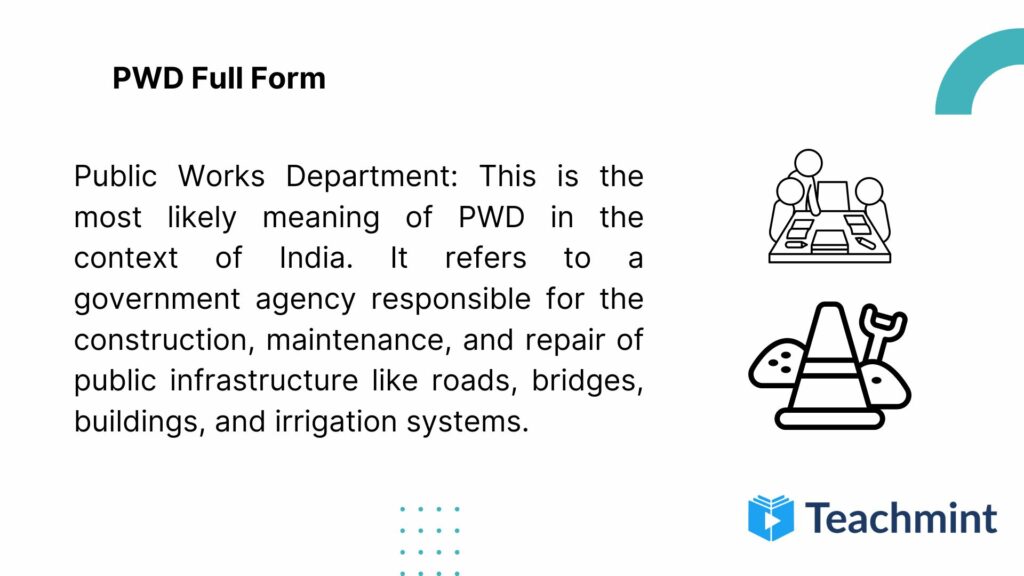In the realm of acronyms and abbreviations, “PWD” is one that holds significant importance in various sectors worldwide. PWD Full Form for “Public Works Department,” a term commonly used in government administration, particularly in the context of infrastructure development and maintenance. In this article, we delve deeper into the meaning of PWD, its functions, and its importance in shaping the built environment.
Understanding PWD:
The Public Works Department (PWD) is a government agency responsible for the planning, construction, operation, and maintenance of public infrastructure. This infrastructure encompasses a wide range of facilities essential for societal functioning, including roads, bridges, dams, water supply systems, public buildings, and more. PWDs exist at different administrative levels, from local to state or provincial to national, depending on the country’s administrative structure.
Functions of PWD:
- Infrastructure Development: One of the primary functions of the PWD is to plan and execute infrastructure development projects. This involves conducting feasibility studies, designing structures, procuring materials, and overseeing construction activities to ensure the timely and cost-effective completion of projects.
- Maintenance and Repair: Apart from building new infrastructure, PWDs are also tasked with maintaining and repairing existing facilities. This includes regular inspection, routine maintenance activities, and emergency repairs to ensure the safety and functionality of public assets.
- Disaster Management: PWDs play a crucial role in disaster management and response efforts. In the aftermath of natural disasters such as floods, earthquakes, or cyclones, PWD teams are mobilized to assess damage, restore essential services, and rebuild infrastructure to facilitate recovery efforts.
- Urban Planning: PWDs contribute to urban planning by providing expertise in the development of master plans, zoning regulations, and infrastructure layout designs. They collaborate with other government agencies and urban planners to ensure sustainable and efficient use of land and resources in urban areas.
- Environmental Conservation: PWDs increasingly focus on incorporating environmentally sustainable practices into infrastructure development and maintenance activities. This includes implementing measures to reduce carbon emissions, conserve natural resources, and mitigate the impact of infrastructure projects on ecosystems.

Importance of PWD:
- Critical Infrastructure: Public infrastructure is the backbone of modern society, facilitating economic activity, mobility, and social interaction. PWDs play a crucial role in ensuring the availability and functionality of essential infrastructure that supports various aspects of daily life.
- Safety and Security: Well-maintained infrastructure contributes to public safety and security by reducing the risk of accidents, structural failures, and disruptions to essential services. PWDs’ focus on regular maintenance and timely repairs helps mitigate potential hazards and ensures the reliability of public assets.
- Economic Development: Infrastructure development projects undertaken by PWDs stimulate economic growth by creating employment opportunities, attracting investments, and improving connectivity between regions. Investments in infrastructure such as roads, ports, and utilities enhance productivity and competitiveness, driving overall economic development.
- Quality of Life: Access to reliable infrastructure services, such as clean water supply, transportation networks, and public amenities, directly impacts the quality of life for citizens. PWDs contribute to enhancing living standards by providing and maintaining essential infrastructure that meets the needs of communities.
- Resilience and Sustainability: In an era marked by environmental challenges and climate change, PWDs play a vital role in promoting resilience and sustainability in infrastructure development. By adopting sustainable practices and integrating resilience measures into projects, PWDs contribute to building infrastructure that can withstand future challenges and minimize environmental impact.
Conclusion:
In essence, the Public Works Department (PWD) is a cornerstone of public administration tasked with the vital responsibility of planning, building, and maintaining infrastructure that supports societal needs. From roads and bridges to water supply systems and public buildings, PWDs play a multifaceted role in shaping the built environment and enhancing the quality of life for citizens. As we navigate the challenges of the 21st century, the importance of PWDs in fostering sustainable development and resilience in infrastructure cannot be overstated.
Learn more about Teachmint plans here.
